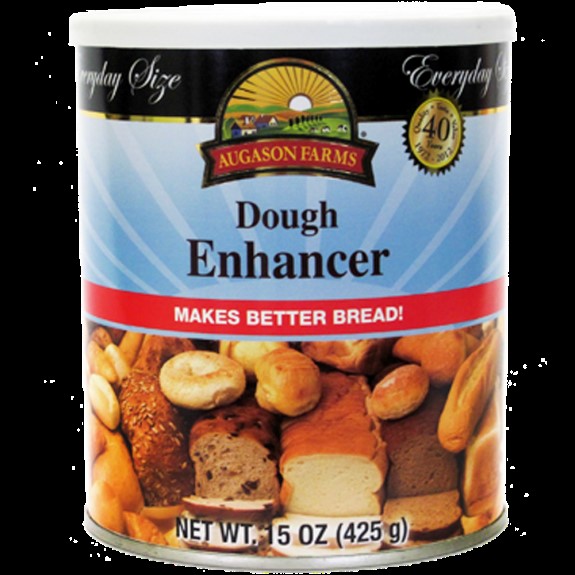The Benefits of Dough Enhancer You Don't Want to Ignore
For you avid bread makers, let's talk about dough enhancers. There are some very good reasons why you want to add a dough enhancer to your recipe:
- It improves the rise of bread
· It improves the texture of bread
- It improves the taste of bread
- It improves the crust of bread
- It makes a "lighter" bread
· It EXTENDS SHELF LIFE (it's a NATURAL preservative)

There are several commercial brands. Augason Farms, Honeyville Farms, L'EQUIP Enhancer, Hills Mills, are just a few brands available.
But there's no need to buy a dough enhancer, since it's very easy to make. While they're used primarily for making whole grained breads, they're a nice addition to white flour breads as well.
Here's what's needed to make your own dough enhancer, according to the folks at Honeybee Pantry ( www.honeybeepantry.com ):
(1) GLUTEN: The dough's muscle. (I like Vital Wheat Gluten from www.honeyvillegrain.com.) Gluten is already in wheat (as microscopic strands of protein), but adding a small amount creates a more elastic loaf; whole grains tend to be heavy and their bran is a hindrance to elasticity. Bran damages the existing protein strands as they are being worked.
Gluten helps whole grain breads gain strength and elastic texture while being kneaded. By working the dough roughly, gluten is activated. (After kneading, the dough should have a smooth and soft texture, like a baby's bottom.)
Gluten also helps increase the bubbles in whole grain breads, contributing to lighter texture. The heaviness of whole grain can pop bubbles too early, which makes the bread sink in the middle.
Gluten also improves nutritional value and provides the bread with a longer shelf life; and it makes thin slicing without breakage possible.
NOTE: Using all purpose flour doesn't require much additional gluten (because it isn't heavy, and it doesn't have any bran).
(2) POTATO FLAKES: A great companion to gluten. Potato flakes create an outer casing to the "gluten bubble" which strengthens it so it won't pop. The bran in whole wheat is like sandpaper, very coarse, and as it mixes with the bubbles it can pop them unless there is a strong casing to prevent this.
Potato flakes deposit sticky starch into the bubbles that form, preventing air from escaping. The result is a nice, light texture.
(3) ACID: APPLE CIDER VINEGAR, or white vinegar or ascorbic acid (vitamin C) . As yeast eats sugar, it creates air bubbles. While gluten strengthens those bubbles, it needs help in keeping the integrity of that strength so the bubbles won't pop during kneading and rising.
Adding vinegar preserves gluten bonds, keeping them from popping. Adding an acid also keeps the yeast happy and helps it to work better. Don't worry-you will NOT taste it.
If your recipe already includes Vitamin C, and you want to keep it, then don't add vinegar. (If you'd rather use ascorbic acid powder or a crushed Vitamin C tablet, use ¼ tsp per loaf (a little suffices; more is NOT better.)
I prefer Apple Cider Vinegar (ACV) because of its indefinite shelf life (even when opened; no refrigeration needed), and because it's so good for the body in many other ways.
(4) LECITHIN: Lecithin (found in health and whole food stores) contributes to a soft texture and prolongs freshness. It enhances elasticity which allows for better rising. It gives the bread that "store-bought" texture without compromising the quality or nutrition of the loaf; it also makes the crust tender .
Lecithin comes in granules or liquid, but using granules allows you to make a mixture of all the dry ingredients that make up a dough enhancer.
NOTE: If your recipe calls for egg, then you're using lecithin in a sense. The egg yolk is lecithin- rich. The drawback to egg, however, is that it shortens the bread's shelf life.
Lecithin has so many benefits. Research from MIT proved that the amount of lecithin eaten directly affects the chemical activity of the brain. Lecithin is necessary for optimal cell and organ health and is found in every cell or organ in the body. By eating it in sufficient amounts, it's possible to rebuild damaged cells and organs. Once they are repaired, lecithin helps to maintain their health.
Besides using it in bread making, add some to your daily smoothie, because lecithin can:
· reduce cholesterol levels in blood and helps dissolve existing arterial plaque.
· help eliminate the yellow or yellow-brown plaque around the eyes caused by fatty deposits.
- help lower blood pressure.
· produce greater alertness in the elderly.
· helps heal disturbances (eczema, acne, psoriasis) and can fill out and soften aging skin.
· serve as a natural tranquilizer, aiding in nervous exhaustion.
(5) GINGER: Like lecithin, it's a mild preservative. But its big perk: yeast loves ginger, so it gives the yeast a solid kick start. A tiny amount (1/4 tsp per loaf) won't be enough to add any taste and it'll help make the bread fluffier.
(6) DRY MILK POWDER: Dry milk helps relax the dough, which makes rolling and shaping easier. It helps the crust brown, adds moisture, enhances taste, and improves cell structure (causing them to have a stronger web and sturdier lift).
HOMEMADE DOUGH ENHANCER
1 tablespoon vital wheat gluten for every cup of whole grain flour. (For 10-12 cups whole grain flour use from ¼ - ¾ cup of vital wheat gluten)
¼ cup potato flakes per loaf of bread
Apple cider vinegar, equal to yeast amount called for in recipe
½ teaspoon lecithin per loaf of bread
¼ teaspoon ground ginger per loaf of bread
1 ½ tablespoons dry milk powder per loaf of bread
Add ingredients to the flour in bread recipe and mix thoroughly per recipe directions.
 Alice Osborne
Alice Osborne
Weekly Newsletter Contributor since 2006
Email the author! alice@dvo.com
